Witnesspedia
child:
title: The History of Witness
slug: history
parent: 15312
summary: The History of Witness
keywords: worldbuilding, partipatory
image: https://edgeryders.eu/uploads/default/original/2X/6/658d2d207954827490390655439ac803d6dc53e4.jpeg
The History of Witness {style=“color: #fff; text-shadow: 2px 2px #000; padding-bottom: .4rem; font-weight: bold;” class=“leading-tight text-4xl”}
The most populous seasteading megacity on record {style="color: #fff; width: 80%; padding-top: 1rem; border-top: 1px solid white; background-color: rgba(0, 0, 0, 0.4); " class=“text-2xl mt-4 mx-auto leading-normal”}
Witness is the most populous seasteading megacity on record. Initially developed under Project Viking (which gave birth to other noted cities such as Byzantium and Vivarium), Witness grew far beyond its original physical and legal bounds, and today is considered the cultural, financial and media capital of the post-Sundering world. Doubly so since it both anchors itself to semi-stable landmasses and produces new ones of its own: it is therefore a navigational landmark in this post-climate-change reality.
Whereas most other Project Viking cities operate as a single territory overseen by a single government and State Machine, Witness operates as a collection of interdependent Distrikts that function de facto as city-states in their own right. Each city-state is an implementation of a particular set of economic, philosophical and moral social contracts, although some aethnographers have pointed out the phenomenon of boundary bleed (which is almost unseen in other cities) [6]. Between the Distrikts runs the Migrant Train, a zero-cost solution for citizens who wish to live under a different social contract. While the State Machine of Witness is de jure overseer of all territories, in reality it manages only portions of infrastructure, guides multi-distrikt disaster response, and policing in instances where inter-Distrikt conflict seems imminent.
THE FOUNDING
“As with all great cities, much of the founding of Witness is lost. What remains are skeleton logs preserved in machine memory, wrapped in a cocoon of half-myths, apocrypha, and clashes between rival historians. Move three districts and the stories change. On such a tenous sea we are now adrift, and it is up to us to make sense of it.”
– Andromache Kosovitch, Aethnography: The New Histories of Our Times, the Library of St. Benedict
The general consensus is that Witness began as an experimental habitat conceptualized during the Post-Plague Years by one Jonathan C. Denton, an official of some import at an Old-World entity known as the United Nations. Denton, by his own admission, was involved in a collaboration between a group of private technology corporations and a sub-branch known as UN-Habitat; the goals of this collaboration were to launch twelve floating cities that could weather climate change, support a substantial population, and serve as highly mobile support stations for areas ravaged by rising sea levels and erratic weather.
Often referred to in recovered public news archives as Project Viking, the collaboration led to both advances in design and the development of a number of modern technologies, including what we know as the State Machine and the Ramos Harvester. [2] Initially criticized as “techno-futurist doomsday bunkers”, Viking became a key point in the affairs of the Post-Plague Years.
Denton, however, became increasingly disenchanted with the utilitarian design of governance for these cities. His earliest writings explored the alternate theories of one T.M. Scalon, a philosopher who proposed a way of living based on mutual recognition of wrongness [3]. Along with the architect Minette de Silva, the economist Rohan Kapoor and ten others [4], Denton marshalled resources and participants for a thirteenth city, designed in a far more modular fashion: the city of Witness [5].
Perhaps in an effort to signal its departure from the finely tuned modernist designs of other seasteading cities, Denton and de Silva peppered Witness with eclectic buildings riffing off a wide variety of architectural styles. Early concept art for some of these designs survived in Denton’s Manifesto, providing a fascinating glimpse at his personal aesthetics. Buildings as “Newton’s Folly” (pictured above in original sketch form) eventually became bizarre and unusual meeting chambers for the governing bodies of Witness.
THE EARLY YEARS AND THE STATE MACHINE
Aethnographers rarely agree as to the exact year when Witness came to be, but the general consensus is that it launched around the time of the Sundering. As a result, Witness was launched with an eclectic mix of volunteers, the workers themselves, and personnel rescued from the regions around the launch point.
This mix Denton would decry as “suboptimal” and spend the rest of his years managing, but much aethnographic evidence has been put forward supporting the idea that the influx of skilled workers actually helped Witness survive the Sundering and make it more independent than the rest of Project Viking.
Denton would spent his days rescuing climate change refugees from the nearby coastlands and compiling his Manifesto, using Witness as an argument for contractualism as the way forward. Minette de Silva oversaw constant overhauls to infrastructure, architecture and propulsion, and as a consequence may have contributed more to the ultimate functioning of Witness than Denton did. She is referred to as the first Mayor of Witness in the Manifesto, but only in passing; few other records remain of these years. Of other figures listed as founders of Witness - including Rohan Kapoor - very few verifiable records remain, but apocrypha is rife on the topic.
One of the components of all Project Viking cities was the State Machine - a next-generation governance system designed to use behavorial big data to dynamically impute the needs of a populace and adjust laws and policies to suit. Most known State Machines, such as those of Byzantium and Vivarium, rely on a form of utilitarianism [7]. Denton’s records indicate that the Witness State Machine was modified (by Rohan Kapoor and a team of software engineers known as the CIVICSMOD group) to support Denton’s interpretation of contractualism.
Part university, part fortress: the concept art for Library of St. Benedict, which contains both the State Machine’s core hardware and the CIVICSMOD quarters. The towers were meant to be part of a fin-style passive cooling solution for the heat generated by the processors.
While initially successful, dissent and this nonstandard State Machine would lead to the events of Breakpoint and the present structure of Witness. CIVICSMOD, which took up support functions throughout this period, retained those functions over many resignations and generations of political upheavel, and is presently the dominant technical voice on the Distrikt Council.
THE ZERO-DAY FRACTURE
.
“If anything, Witness is the death of a singular vision and the celebration of multiplicity: the greatest living example of the hive mind triumphing over the auteur.”
– Andromache Kosovitch, Aethnography: The New Histories of Our Times , the Library of St. Benedict
The span of events collectively known as Zero-day / 0D (0 0D - 7 0D) is what gave Witness two its most unique characteristics: the Distrikt system and the Migrant Train.
It began with community leaders Megan Rilke and Karunasalam Balraj vocalizing migrant workers’ dissatisfaction with Denton’s policies, which they saw as overwhelming favoring his preferential populations and disenfranchising the rest of Witness. Their work elicited both outcry from many of the original United Nations personnel and public support of notable figures such as Minette de Silva and Ebunoluwa Akinyemi, then a rising conservative activist with strong ties to the major churches that eventually formed The Covenant.
A slew of speeches and petitions were subsequently ignored by Denton and his core team, leading to the First March of the Voiceless in -3 0D [8]. The marches were met with outcry and, in some boroughs, with violence.
Subsequent to the Marches, the State Machine apparently reached a calculation failure in its attempts to impose a framework that would allow everyone to operate under one government. Thus it sanctioned a divorce, or a fracture in populations. In 0.5 0D, vacant infrastructure (set aside for later growth) was partitioned into Distrikt 2.
By the new year, a 12-person D2 Steering Committee had been appointed, with community leaders given seats and Karunasalam Balraj voted in as the Chairperson. The newly formed Distrikt 2 attracted both anti-Denton dissenters and those who felt uncomfortable under the State Machine. D2 would eventually become the Distrikt we know as Libria.
The Zero-Day Fracture was of such significance that the Witness calendar was reset around this inciting event. The name comes from public accusations by Denton that Kapoor and the CIVICSMOD team sabotaged the State Machine by introducing logical vulnerabilities that they should have known of. The Fracture marked a significant downturn in Denton’s power over Witness.
Because practical communication with the State Machine was still required, the CIVICSMOD team, various other special interests and Distrikt 2’s nominees formed the Distrikt Council, which eventually would grow into the intra-Distrikt legislative body.
For another, it was seen as a failure of contractualism’s ability to incorporate multiple worldviews, and thus set the seeds of the State Machine’s lack of power in certain Distrikts. It also led to multi-Distrikt structure of Witness today: because of its original failure, the State Machine continues to rapidly sanction and invest in economic and political experiments, in desperate search for a perfect society.
Shortly afterward, in 4 0D, Ebunoluwa Akinyemi would be the first to take advantage of this experimental tendency and spearhead the launch Distrikt 3, which would eventually become the Covenant. By 7 0D Witness would be not one, but three floating cities in one space, tentatively rebuilding after a seven-year period of intense political tension.
THE HARVEST DIVISION
Subsequent to these events, many at time felt that critical infrastructure - especially energy generation - was not evenly distributed among the different Distrikts. A anarcho-collectivist movement known as the Microgrid Collective carried out an extremely popular campaign for decentralized, open-source, community-maintained energy generation structures to be set up throughout Witness.
Due to resource constraints, their goal was not met, though the Distrikt currently known as the Assembly both uses this design for their energy grid and directly credits the Microgrid Collective for it. At the time, the general unrest created by the Microgrid Collective led to fears of sabotage, which would have spelled the end of Witness.
Thus limited resources at the time, and the now-distributed engineering skills, were channeled by the Distrikt Council into creating a single central power station, built on neutral ground, politically agnostic and bound to supply each Distrikt with an minimum (and equal) amount of energy.
In return, each Distrikt would contribute to the upkeep and maintenance of said division, and accord its workers maximum protection under their laws. Any energy requirements beyond the yearly calculated minimum would be the responsibility of each Distrikt.
This unit was called the Harvest Division. Gregory Ramos, Joriam Vidal and S. A. Helani Saranasekara - engineers representing each Distrikt - were brought on to lead the newly-created unit.
The Harvest Division is both a politically and geographically important structure in Witness, as it sits at the physical center of mass of Witness and extends connections to practically every Distrikt, new or old. Seaside and Harvestside are often street slang for road directions.
As Witness grew, the Harvest Corps began to lend engineering support and technical oversight to other projects, turning into a infrastructure-related political power in its own right, albeit one with a reputation for impartiality. Such is the power of the Harvest Division that the traditional three-way leadership at the top is informally known as the Troika. Harvesters - distinctive in their blue uniforms - are often welcome, or at least left alone, throughout Witness.
LIBRIA, AVANTGRID, THE ASSEMBLY OF PEOPLE, AND THE DESOLATION OF HYGGE
Both Libria and The Assembly had uneasy births. General dissatisfaction led to splits, and Denton’s increasingly authoritarian actions radicalized many against the sort of governance Witness was intended to have. Internally, Witness was equally troubled: Denton, over the years, disposed of his founding team and continued his rule against the carefully worded internal recommendations of the State Machine.
Avantgrid was the first Distrikt that was formed through a conscious effort of a group to force the State Machine to fracture by assembling a group of like-minded people with an agenda. Eco-pragmatists flocked to an artificial archipelago in Libria with the intention of turning it into a new distrikt. This period, although short, was an extremely violent part of Witness history, as the corporations of Libria fought to prevent the fracture. This has created a deep gulf of suspicion and distrust between the people of Avantgrid and Libria ever since.
The splitting off of Libria, subsequent conscious fracture of Avantgrid, and the formation of Assembly spelled the death of the city-state of Witness, as existing infrastructure had to be partitioned off. The core of this type of governance and the scope of its powers was thus cut down to just Hygge.
The stabilization of this system also led the State Machine to launch the microDistrikt initiative (it may have been inspired by the Microgrid Collective and the growth of the Assembly, although whether inspiration works the same way for AI is a subject for debate). Directive 12.22, designed and tested over many years, spelled out the conditions and need for this initiative:
-
No single governance system can account for all human preferences. Therefore, people must have choices available to them.
-
Diverse types of governance increase the overall survivability of Witness as per Project Viking’s goals, to which the State Machine remains irrevocably committed.
-
However, space and resources are at a premium. Constant, enormous schisms will also lead to mass public unrest, systemic instability, and general failure of Witness.
-
Therefore, all Distrikts agree to donate space and resources for people to test out new economic and political systems and new social contracts with a limited population of experimentors and people who express dissent for existing systems. These areas will be known as microDistrikts. They will receive the full organizational support of the State Machine, and should any of them achieve stability and a certain degree of self-sufficiency, they will be brought into the fold as full-fledged Distrikts with access to the Ramos Harvester, additional funds, and representation on the Distrikt Council.
THE MIGRANT TRAIN
Imagine a voice.
It is telling you, *Citizens, we are now entering the Assembly. The social contract here is as follows: such-and-such morals are what they live by: please refer to the article displayed on the terminal-walls. If you agree to the terms of the Assembly, disembark here.’
Or, Citizens, we are now entering Libria. Please note that this state has less legal protections for your person than most, and we recommend you study it carefully before entering. If you accept, disembark here.
Imagine, if you will, people, of every size and shape and color, watching these stations go by. Some nod and leave, and breathe the air outside, as if in relief to have finally found a people among whom they can be comfortable. Others nod and wait, hoping for a better life at the next track.
Some wait forever.
– Anagram Dias, aethnographer, The Assembly
The Migrant Train is a feature entirely unique to Witness among all the known floating cities spawned by Project Viking. Designed by engineers from the Assembly, the Migrant Train is a publicly owned and operated monorail that runs through every single Distrikt and major region of Witness.
It allows people who feel as if they do not belong to migrate freely to other Distrikts; at every stop, it spells out the social contract in the area, and allows people to either disembark as new citizens or leave.
Its sanctity is ensured by State Machine charters (tied to power from the Ramos Harvester and the right to representatives on the Council) and a contingent of armed guards that report directly to the State Machine, and have a first-principle monopoly on violence on anything that affects the Migrant Train. As an unexpected side effect, the Migrant Train is home to people known as the Permanent Migrants, who prefer not to engage with any Distrikt and instead eke out a living transporting goods to and fro via the Train. Many Permanent Migrants have become guards and engineers maintaining the Train.
REFERENCES
[1] A Record of a Seabourne Few, Denton, Manifesto. Now collectively known as the Old Manifesto.
[2] Partial public data trails of Project Viking, recovered primarily from the Exodus of New York, indicate the successful launch of Byzantium, Vivarium and at least three other cities.
[3] What We Owe to Each Other, T.M. Scanlon, archive unindexed
[4] Given how drastically different names are put forth in different sources, some suggest the Missing Ten are apocryphal. Other scholars point to the more realistic construct of a a power struggle and history being written from a particular narrative standpoint.
[5] Scholars such as Kosovitch have advanced the claim that Denton chose the name out of spite, pointing to the famous undated 2nd Entry in the Old Manifesto:
“There’s a way forward and they’re too blind to see it. Will need to show them.”
and the etymological link between “see”, “show”, “witness” and the 42nd Entry:
"From Google:
- have knowledge of (a development) from observation or experience.
- be the place, period, or setting in which (an event or development) takes place.
- be a sign or proof of (something); serve as evidence."
The entity ‘Google’ is unspecific: it seems to have been both a noun, a verb and some kind of all-knowing entity: some technological scholars theorize would have been accessible at the highest levels of the United Nations, while aethnographers frequently connect it to the similar construct of the Oracle in mythohistorical records from much earlier in history, suggesting that at recurring periods our ancestors have worshipped the same knowledge-giving entity, or different entities with extremely similar functions.
[6] The theory that portions of the populace along the boundaries of adjacent states approach either temporary compatibility or conflict, and often oscillates between them depending on the relative sizes of the populations involved. See also: coasian bargaining.
[7] A system described by a little-known science fiction writer called Genesis Wijeratne, then later prototyped by a university research project, then developed a private software corporation founded by one of the researchers, and upsold to the United Nations.
[8] Chronicled in The Voiceless, Catia E. Andrejas, the Library of St. Benedict. A heavily abbreviated version is available in the Standardized Syllabus taught in most Distrikts.
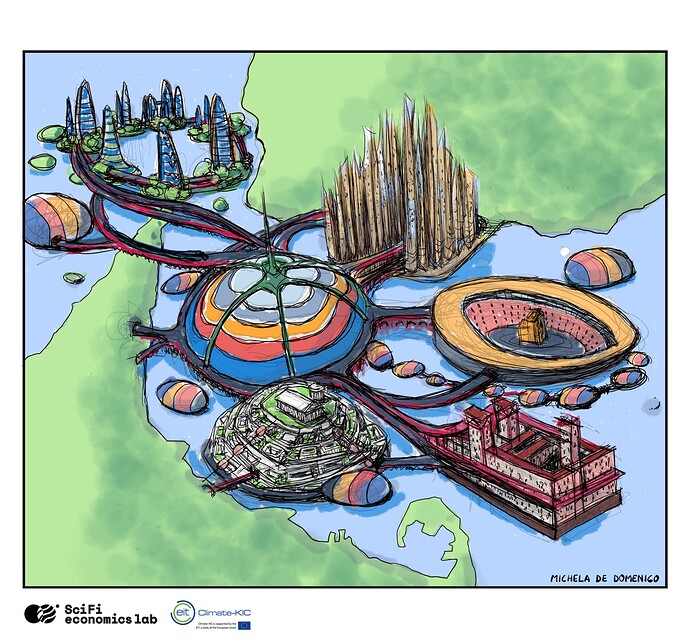
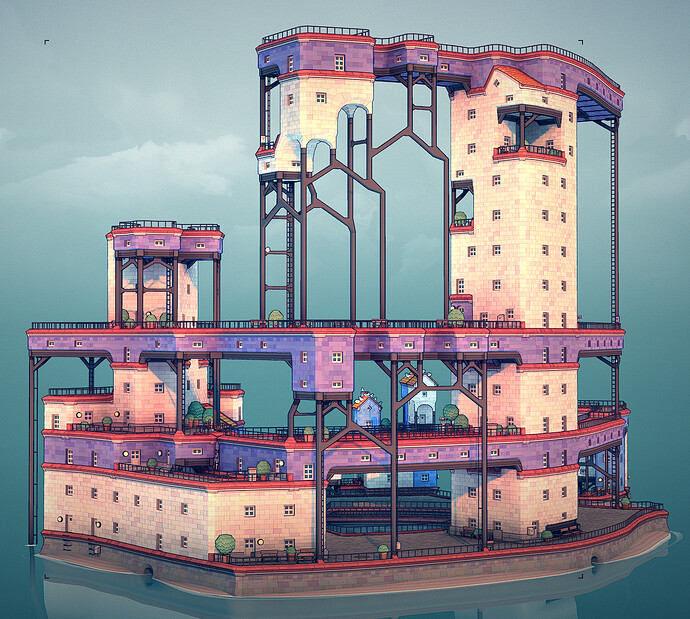
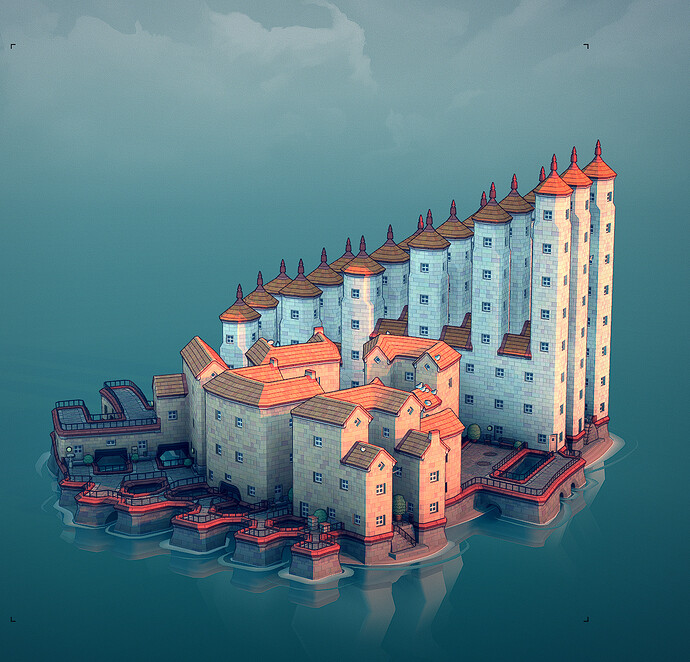
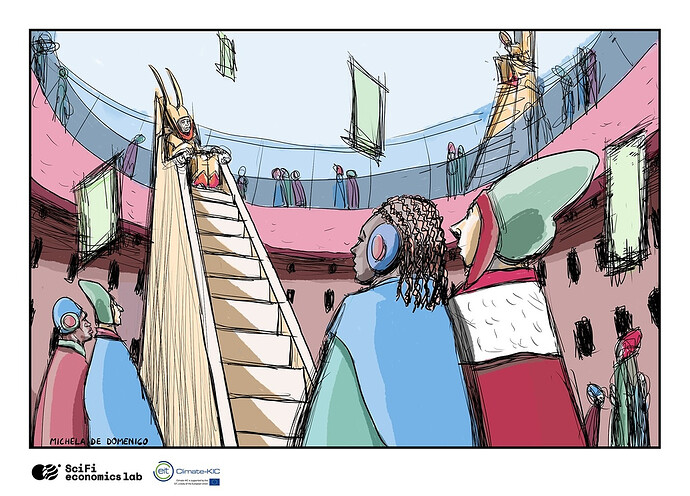
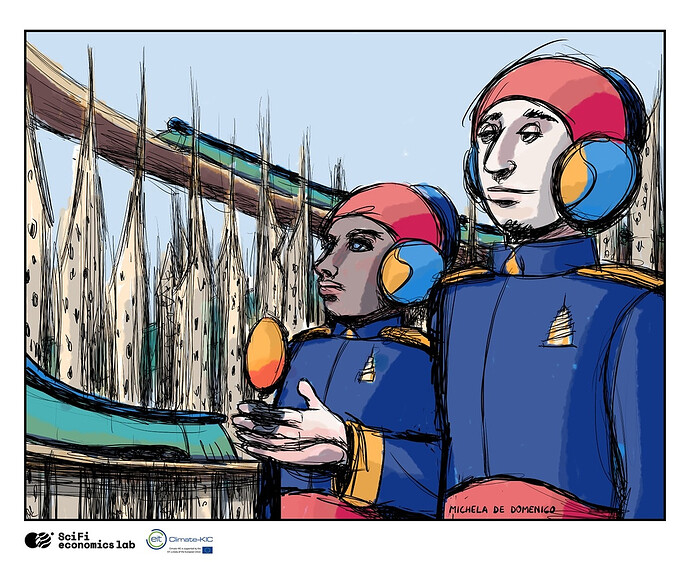
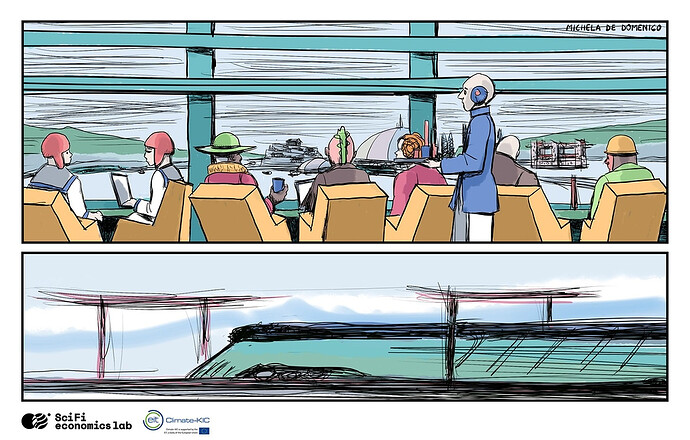


 I’m planning on fleshing those out at some point (short stories, entries for the wiki, things like that!)
I’m planning on fleshing those out at some point (short stories, entries for the wiki, things like that!)
